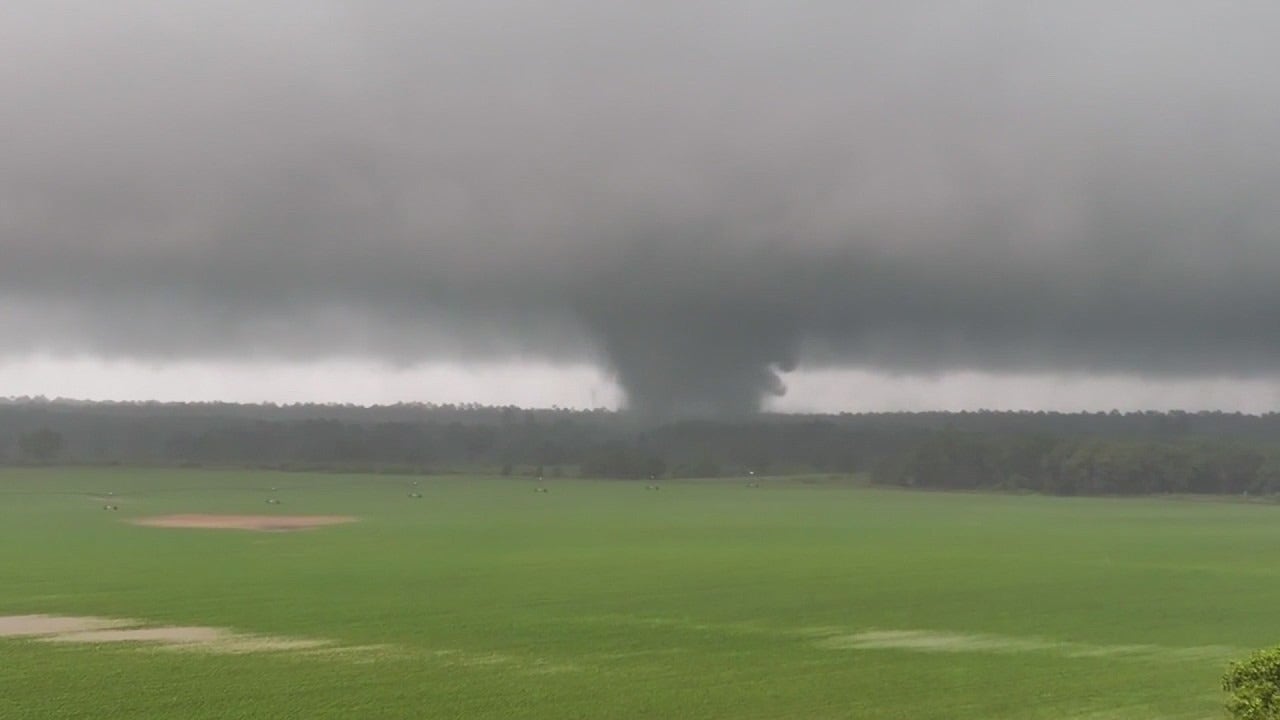Illinois
The Tornado State: Illinois emerges as new hot spot for twisters, defying traditional patterns

Illinois emerges as new hot spot for tornadoes
The Prairie State could soon be known as the tornado state. So far this year, Illinois has seen the most tornadoes in the United States, and the most severe weather events.
CHICAGO – The Prairie State could soon be known as the tornado state. So far this year, Illinois has seen the most tornadoes in the United States, and the most severe weather events.
In a FOX 32 special report, chief meteorologist Emily Wahls explains what’s going on.
There’s a new trend storm chasers are following. It shows tornado alley isn’t the only hot spot for this major weather event.
“One of the things that we’re noticing is that there’s been a decreasing trend, a decreasing number of tornados in the Great Plains and an increase in places further to the east, and the mid-south and portions of the Midwest,” said Dr. Victor Gensini, associate professor of meteorology at Northern Illinois University.
SUBSCRIBE TO FOX 32 ON YOUTUBE
Gensini is also a storm chaser and one of the first meteorologists to report a shift in the frequency of where tornadoes are touching down in the U.S.
He and a team of other weather experts first noticed this trend in 2018. Five years later, they say it’s still swirling.
“So it’s a very interesting trend and then the issue becomes how to explain that trend,” Gensini said.
“We don’t know. We think some of it’s climate change. We think some it is the central plains drying out, becoming a more desert like, arid climate. And places further to the west see more rainfall.”
The shift Gensini helped discover focuses on the number of EF-2 and stronger tornadoes now occurring outside the traditional tornado alley. Places like northern Mississippi, Alabama, Tennessee, and Arkansas.
“So when a tornado happens in these areas east of the Mississippi River, we see more impact. More hazards, right? Because there’s more people, there’s more targets, there’s more assets for these storms to hit,” he said.
The tornado that tore through suburban Chicago in June 2021 was an EF-3. It left a heavy trail of destruction in Woodridge and Naperville.
“The devastation here is unbelievable. It’s one of those things you don’t expect it in your neighborhood,” one Woodridge resident said at the time.
For Illinois, Gensini says it’s seeing an increase of about three more strong tornadoes every decade.
“Tornados are relatively rare. It’s very rare to be hit by a tornado in downtown Chicago, but when you start aggregating over a decade, an increase in two or three or four in a decade is a pretty big increase,” Gensini said.
What is really noticeable in Illinois, especially this year, is more EF-0 and EF-1 tornadoes.
“They can still cause loss of life and property. In fact, there’s several documented cases of EF-0 and 1’s causing causalities,” Gensini said.
A March 31 storm brought 16 low-level tornadoes across northern Illinois. All but one were EF-1’s or EF-0’s.
Four people died and dozens were injured. That includes at least 40 concert goers who were at the Apollo Theatre in Belvidere when an EF-1 caused the roof to collapse.
“They acted quickly to remove debris from people, because people were trapped under debris,” said Dan Zaccard, Boone County emergency management director.
So far this year, Illinois has seen at least 100 tornadoes on all levels of the Enhanced Fujita Scale. That’s nearly double the number the state typically sees, according to the National Weather Service.
While the number of tornadoes we see each year is expected to keep increasing, Gensini says climate change will only be partly to blame.
“There’s more assets for these storms to hit. So as we go forward over the next 50 to 100 years, we will see, regardless of climate change, more and more tornado disasters because of this increase in the human footprint, in the human-built environment,” he said.
Tornado rips roof off theater in Belvidere, Illinois, killing one person and leaving dozens injured
The cleanup began on Saturday after a tornado ripped the roof off the Apollo Theater in Belvidere, Illinois. One person was killed and dozens of others injured.
Case in point, Gensini and his fellow researchers estimate if a tornado today took the same track as one did in 1990 through Plainfield, the damage would be ten times worse.
So if there are more existing homes and more low-level tornadoes happening, what can you do to make your house tornado resistant?
“One of the biggest things people can do right off the bat is look at their garage door,” said University of Illinois climate specialist Duane Friend. “The garage is one of the most susceptible areas on a house.”
Friend says garage doors can be the first point to give way on a house during a tornado because heavy winds can access it pretty easily.
That’s why he says having a garage door that is insulated is a good idea. That type of door is heavier and less likely to give way to strong winds. Friend also says there are “hurricane proof” garage doors.
“The roof would be the second thing that can go, and what will happen with the garage, as the garage fills up with air and that pressure increases, that’s when the roof on the garage goes off,” Friend said.
“The good news is roofs have to be replaced on a regular basis. Anyway, the typical design life of a roof is maybe 15 to 25 years,” said Marc Levitan, lead researcher with the U.S. Commerce Department’s National Windstorm Impact Reduction Program.
Levitan says when it’s time to replace your roof, you should ask your contractor about taking these steps.
“So we’re going to do two things. We’re going to put ring shank nails to hold the roof deck down better and we’re going to put “peel and seal” tape on all of the joints,” he said.
Levitan says that tape will help keep water from damaging your roof.
If possible, Levitan also suggests having your contractor use hurricane clips to reinforce the connection between the rafters and the top of the wall.
Despite all that, Gensini says the most important tornado safety step you can take is this.
“I think it’s really prepping yourself before prepping your home that really is the most important. Have a way to receive watches and warnings and have a plan of action. You can’t wait for the house to be falling down around you before you take action. You need to know what to do when these situations occur,” Gensini said.
While we tend to focus a lot on tornadoes happening, especially during severe weather season – April to June — the reality is a tornado can happen anywhere in the U.S., and it can happen at any time of the year.
For more information on how to make your house tornado resistant, visit the University of Illinois’ Windstorm Mitigation Manual.

Illinois
Andy Katz, Jon Rothstein, John Fanta Weigh In on Illinois Basketball

Illinois (20-11, 12-8 Big Ten) closed out its regular season in spectacular fashion, finding itself back in the AP poll for the first time in over a month after stringing together three straight wins.
And they weren’t just any wins, as the Illini scored a pair of 20-point blowouts over Iowa and No. 22 Michigan (in Ann Arbor) before taking down No. 20 Purdue 88-80 in an electric season finale in Champaign.
Playing its best basketball since early January, Illinois has found its footing just in time for postseason play – and the college basketball world is taking notice.
Here are the latest Illini takes from the NCAA’s Andy Katz, CBS’ Jon Rothstein and FOX’s John Fanta:
Katz
Illinois had Final Four hopes heading into the season, a ceiling considered by outsiders to be sky-high and, by January, a proven product on the floor – until a 5-8 patch turned the Illini into an afterthought. But with the team’s three-game winning streak to end the regular season, Katz said the “Illini are back to being the team that was projected after a thrilling win over Purdue,” which has earned them the No. 17 spot in his rankings.
Rothstein
In his Monday morning edition of the “Rothstein 45,” Rothstein listed Illinois at No. 26, keeping his analysis short and sweet, pointing to the emergence of Tre White – who is averaging 17.3 points per game over his past four contests.
Fanta
The Illini moved to No. 21 on Fanta’s list, as he was impressed with their Friday showing against the Boilermakers. Fanta noted Illinois’ ability to defend down the stretch against Purdue and the offensive talent the Illini possess. That combination on both ends led to Fanta saying, “There’s a reason to believe that this team can make the second weekend of the Big Dance.”
KenPom’s Metrics Are High on Illinois Basketball’s NCAA Title Hopes
Purdue Coach Matt Painter Sets the Bar for Illinois in March
How Tre White Helped Illinois Basketball Send Purdue Packing
Illinois
House bill to make daylight saving time year-round in Illinois gets committee hearing

Most of the U.S. lost an hour of sleep this weekend after moving clocks forward for daylight saving time, but a bill making its way through the Illinois legislature proposes to make that the last time Illinoisans lose sleep for the tradition.
HB 0039 would amend the Standard Time Act, so daylight saving time would be the year-round standard time of the entire state, according to the bill’s primary sponsor, Rep. Bob Morgan, D-Deerfield.
The bill was assigned to the State Government Administration Committee on Feb. 4, and a hearing is set for March 12.
Morgan said if both chambers pass the bill and the governor signs it, Congress would still have to act for it to go into effect. Congress passed the Uniform Time Act of 1966, which prevents states from permanently observing daylight saving time, though it allows states to observe standard time permanently.
“We basically would be gaining time during the summer months, and it would help us for businesses, for kids — it would change the way that our sunrise and sunset happens in terms of what we think of with our day from a 9-to-5 perspective.”
Republican representatives in Illinois introduced similar legislation in HB 1400. It was assigned to the State Government Administration Committee on Feb. 11, but a committee hearing has not yet been scheduled.
A Missouri Senate bill assigned to a committee last month would establish daylight saving as the new standard time, and other states are invited to join as a pact. But this bill doesn’t have a committee hearing scheduled yet, either. In 2022, the U.S. Senate approved a bill to make daylight saving time permanent nationwide, but the measure didn’t make it through the House of Representatives.
Dozens of states have considered hundreds of bills and resolutions in recent years to establish year-round daylight saving time as soon as federal law allows it, according to the National Conference of State Legislatures.
However, President Donald Trump said last week that ending daylight saving time is a “50-50 issue.” He said some people prefer more light later in the day, while others prefer more light earlier to avoid taking their kids to school in the dark.
Morgan said he’s not sure if HB 0039 will get the votes to become law in Illinois. He said there’s strong bipartisan support in the House and Senate in Washington, D.C.
“It’s more likely than it’s ever been in my lifetime,” Morgan said. “Twice a year, I hear about this from my constituents, old and young, and everyone I know agrees that we need to make a change.”
Illinois
College Achievers: Huber, Boldt help Illinois Wesleyan to dual CCIW wins
Illinois Wesleyan junior Nathan Boldt, a graduate of Barrington High School, operates in the post during a game earlier this month against Carroll University.
Courtesy of Illinois Wesleyan University Sports Communications
Familiar faces at Illinois Wesleyan University helped the Titans win the College Conference of Illinois & Wisconsin women’s and men’s basketball tournaments.
Beating Carthage 79-60, the men’s team won the tournament for the first time since it was held in 2003. Nathan Boldt (Barrington High School), a 6-foot-10 junior forward, came off the bench to grab a season-high 8 rebounds to go with 5 points. Starting senior guard Hakim Williams (Round Lake) and senior forward Marko Anderson (Maine South) were top contributors, and readers may also recall key Titans guards Josh Fridman out of Glenbrook North and Karlo Colak of New Trier.
Junior swingman Griffin Daun (Wauconda) and Carthage saw their season end Friday in an NCAA Division III tournament loss to St. Norbert College, 92-89.
Ranked ninth nationally by D3hoops.com, Illinois Wesleyan (24-5) on Saturday advanced into the tournament’s Sweet Sixteen with a 75-73 win over St. John’s University (Minn.) at the University of Chicago’s Ratner Athletic Center. Colak scored on a putback with 0.3 seconds left. The Titans will visit No. 5 Wisconsin-LaCrosse on Friday.
The Illinois Wesleyan women beat Carroll University (Wis.) 95-86 to win their 11th CCIW tournament title. Star senior guard Lauren Huber’s (Glenbard East) season-high 28 points and game-high 11 rebounds led the effort but she got plenty of help from juniors Sawyer White (Montini) with 17 points and 3 steals and Ava Bardic (Stevenson) with 13 points. Senior Kate Palmer (Geneva) scored 8, and when Carroll pressured early, junior Sara Balli (Lake Park) hit a big 3.
Ranked fourth nationally, Illinois Wesleyan’s women (28-1) advanced to the women’s Division III Sweet Sixteen. On Saturday the Titans beat Trine University (Ind.) 82-50 behind Bardic’s five 3-pointers and 26 points. Wesleyan will host Wisconsin-Oshkosh on Friday at the Shirk Center.
Take the Hintz
A former East Suburban Catholic Conference baseball pitcher of the year, University of Arizona junior Casey Hintz (St. Viator) earned a win in dramatic fashion against then-No. 1 Texas A&M on Feb. 28 in Houston. Hintz pitched 5 innings of relief and got the win when Arizona scored twice in the top of the ninth inning. In the bottom of the ninth with two outs, he allowed the tying runner to reach base before getting a swinging strikeout to end the game. Entering Friday, Hintz had a 2-0 record with a 2.13 ERA and 14 strikeouts in 12⅔ innings pitched.
Back to the Garden
The Great Lakes Valley Conference named Lewis University senior Delaney Garden (Jacobs) its softball pitcher of the week for a second straight week and for the fourth time overall. On the season the left-hander is 7-4 with a 1.59 ERA, 3 shutouts, and in 70⅓ innings has allowed 46 hits while striking out 90 batters. She was also second on the Flyers with a .434 batting average and led the team in runs and total bases while going 11 of 11 in stolen base attempts.
MVFC MVPs
To commemorate its 40th season, capped by North Dakota State’s Football College Subdivision title early in 2025, Missouri Valley Football Conference fans voted for the league’s 40th Anniversary Team.
The results included the following players from Daily Herald turf: quarterbacks, South Dakota State’s Mark Gronowski (Neuqua Valley) and Western Illinois’ Russ Michna (Conant); Southern Illinois running back Tom Koutsos (Marmion), and Western Illinois receiver Don Beebe (Kaneland); tight ends, North Dakota State’s Tom Babicz (Barrington) and Illinois State’s James O’Shaughnessy (Naperville North); and North Dakota State punter Ben LeCompte (Barrington).
Smartie
Speaking of the Missouri Valley, Drake guard Mitch Mascari (Geneva), a graduate student featured previously for his 3-point shooting, made the MVC Scholar-Athlete first team and third-team all-conference. He had a 3.98 grade-point average in finance as an undergrad and now owns a 3.80 GPA in graduate accounting.
-

 Politics3 days ago
Politics3 days agoAgriculture secretary cancels $600K grant for study on menstrual cycles in transgender men
-

 Politics2 days ago
Politics2 days agoRepublicans demand Trump cut American legal association out of nominee process
-

 Politics1 week ago
Politics1 week agoOPM's second email to federal employees asks what they did last week — and adds a new requirement: report
-

 News2 days ago
News2 days agoGene Hackman Lost His Wife and Caregiver, and Spent 7 Days Alone
-

 Politics6 days ago
Politics6 days agoEXCLUSIVE: Elon Musk PAC thanks Trump for 'saving the American Dream' in new million-dollar ad
-

 News3 days ago
News3 days agoStates sue Trump administration over mass firings of federal employees
-

 News3 days ago
News3 days agoTrump Seeks to Bar Student Loan Relief to Workers Aiding Migrants and Trans Kids
-

 News1 week ago
News1 week agoICE is making more arrests, but critics say some claims don't add up



















